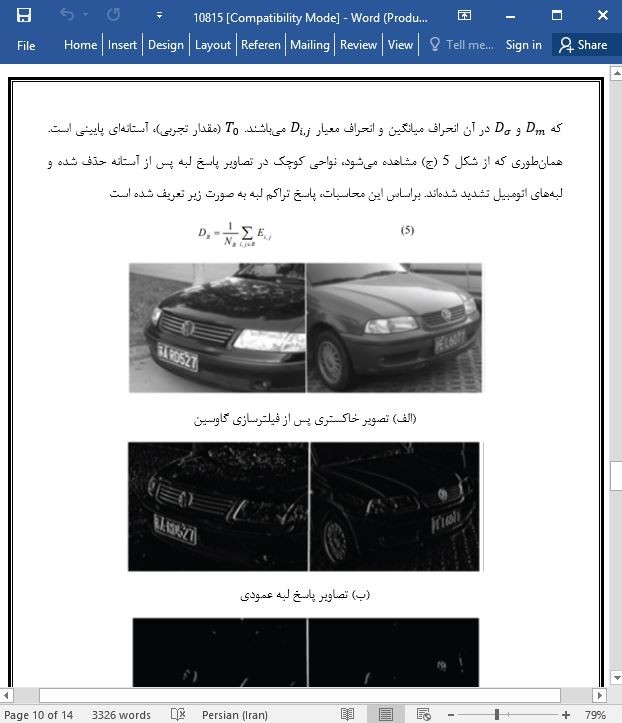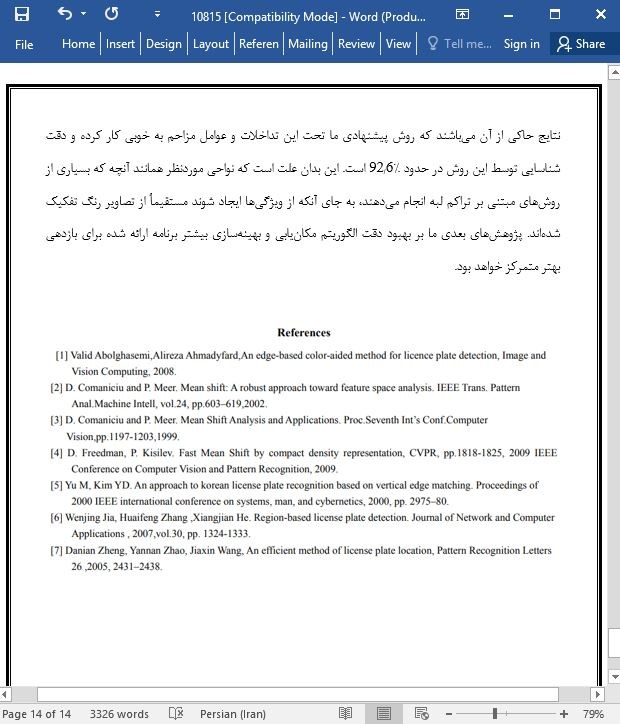
چارچوب جدید استخراج پلاک خودرو بر اساس روش انتقال میانگین سریع
چکیده
استخراج پلاک به عنوان مهمترین مرحله سیستم شناسایی پلاک خودرو (ALPR) تلقی میشود. در این مقاله، روش مبتنی بر منطقه شناسایی ترکیبی پلاک خودرو برای حل مشکلات عملی در زمینههای پیچیدهای که مقادیر زیادی از اطلاعات اضافی و مزاحم وجود دارد، پیشنهاد شده است. در این روش، موقعیت غیردقیق پلاک در ابتدا برای مشخص نمودن بخش جلویی وسیله نقلیه مشخص میشود. سپس از روش انتقال میانگین سریع جدید مبتنی بر نمونهبرداری تصادفی برآورد تراکم کرنل (KDE) برای قطعهقطعهسازی تصاویر رنگ وسیله نقلیه استفاده میشود تا بدین وسیله به محل پلاک موردنظر برسیم. روش قطعهبندی انتقال میانگین، سرعت قابل ملاحظهای را برای ما به ارمغان میآورد و همین امر آن را برای این کار مناسب میسازد. برای تفکیک دقیق پلاک از دیگر مناطق موردنظر از استخراج و طبقهبندی ویژگی استفاده شده است. در نهایت برای مراحل بعدی شناسایی از تنظیم پلاک کج شده (Tilted license plate regulation) استفاده شده است.
1. مقدمه
در سالیان اخیر، سیستمهای حمل و نقل هوشمند (ITS) به یکی از مسائل اولویتدار و مورد توجه در حوزه پژوهشی مبدل گشتهاند. استفاده از فناوری پردازش تصویر برای تحلیل وسایل نقلیه، بخش مهمی در ITS به شمار میآید. موثرترین روش برای شناسایی وسایل نقلیه، جدا کردن پلاک خودروها از همدیگر میباشد. این روش عمدتاً مشتمل بر سه تکنیک میباشد: محل پلاک، استخراج نویسهها و مشخصههای روی آن، شناسایی نویسهها و مشخصات. شناسایی پلاک وسیله نقلیه، یکی از مهمترین بخشها در شناسایی وسیله نقلیه به شمار میرود. دقت و سرعت محل مستقیماً بر عملکرد سیستم کلی تاثیرگذار خواهد بود.
6. نتیجهگیری
پسزمینههای پیچیده و مناظر مختلف، مشکلات عدیدهای را فراروی پژوهشگران ALPR قرار داده است. در این مقاله با در نظر گرفتن این شرایط، روش مکانمحور مبتنی بر الگوریتم جدید انتقال میانگین سریعی ارائه شده است. این روش سریع در مقایسه با پیچیدگی محاسبات روش انتقال میانگین استاندارد، تقسیمبندی رنگ تصویر برای این کاربرد که در آن سرعت بالا موردنیاز میباشد را سودمندتر انجام میدهد. در کتابخانه تصویر تجربی، در حدود 400 تصویر وجود دارد که اندازه آنها در حدود 480×640 میباشند که شرایط مختلفی همچون نوردهی قوی، تخریب پلاک و نماهای مختلف تصویربرداری را در بر میگیرند. نتایج حاکی از آن میباشند که روش پیشنهادی ما تحت این تداخلات و عوامل مزاحم به خوبی کار کرده و دقت شناسایی توسط این روش در حدود %6/92 است. این بدان علت است که نواحی موردنظر همانند آنچه که بسیاری از روشهای مبتنی بر تراکم لبه انجام میدهند، به جای آنکه از ویژگیها ایجاد شوند مستقیماً از تصاویر رنگ تفکیک شدهاند. پژوهشهای بعدی ما بر بهبود دقت الگوریتم مکانیابی و بهینهسازی بیشتر برنامه ارائه شده برای بازدهی بهتر متمرکز خواهد بود.
ABSTRACT
License plate extraction is considered to be the most crucial step of Automatic license plate recognition (ALPR) system. In this paper, a region-based license plate hybrid detection method is proposed to solve practical problems under complex background in which existing large quantity of disturbing information. In this method, coarse license plate location is carried out firstly to get the head part of a vehicle. Then a new Fast Mean Shift method based on random sampling of Kernel Density Estimate (KDE) is adopted to segment the color vehicle images, in order to get candidate license plate regions. The remarkable speed-up it brings makes Mean Shift segmentation more suitable for this application. Feature extraction and classification is used to accurately separate license plate from other candidate regions. At last, tilted license plate regulation is used for future recognition steps.
1. INTRODUCTION
In recent years, Intelligent Transportation Systems (ITS) has been a priority and hotspot issue in the research field . Use the image processing technology to analyze the vehicles is an important part in the ITS. The most effective way to identify the vehicles is to tell the license plates apart. It mainly includes three techniques: Plate Location, Character Extraction, Character Recognition. Vehicle license plate detection is one of the most important part in vehicle recognition. The accuracy and speed of the location will directly affect the performance of the overall system.
6. CONCLUSION
Complex backgrounds and various scenes bring lots of difficulties to ALPR researches. Considering this situation, this paper presents a region-based method based on the new Fast Mean Shift algorithm. Compare with standard Mean Shift’s calculation complexity, this accelerated method make color image segmentation more suitable for this application which has a strict speed requirement. In the experiment image library, there are about 400 images, size about 640×480, including various conditions, such as strong lighting, degrading of license plate, different view of shooting. The result demonstrates our method works well under these interferences, and the accuracy of detection is 92.6%. This is because the candidate regions are divided directly from color images rather than generated from features as most edge-based methods do. Our future works will focus on improving precision of the location algorithm and further optimization of the program for better efficiency.
چکیده
1. مقدمه
2. مکان تقریبی بدنه خودرو
3. روش تقسیمبندی انتقال میانگین سریع
3. 1. انتقال میانگین استاندارد
3. 2. تقسیمبندی تصویر با روش انتقال میانگین سریع
4. استخراج ویژگی
4. 1. انطباق سطح محدب بدنه
4. 2. نسبت ابعادی
4. 3. تراکم لبه
4. 4. طبقهبندی ویژگی
5. تنظیم ناحیه کج شده حاوی پلاک خودرو
5. 1. تبدیل آفین (مستوی)
6. نتیجهگیری
ABSTRACT
1. INTRODUCTION
2. ROUGH LOCATION OF VEHICLE BODY
3.FAST MEAN SHIFT SEGMENTATION
3.1 Standard Mean Shift
3.2 Fast Mean Shift image segmentation
4.FEATURE EXTRACTION
4.1 Convex hull area matching
4.2 Aspect ratio
4.3 Edge density
4.4 Feature classification
5. TILTED LICENSE PLATE REGION’S REGULATION
5.1 Affine transform
6. CONCLUSION
- ترجمه فارسی مقاله با فرمت ورد (word) با قابلیت ویرایش، بدون آرم سایت ای ترجمه
- ترجمه فارسی مقاله با فرمت pdf، بدون آرم سایت ای ترجمه



